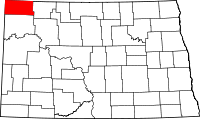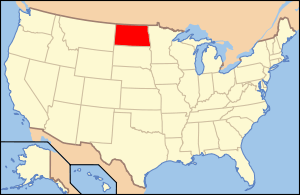Divide County, North Dakota
| Divide County, North Dakota | |
|---|---|
 Divide County Courthouse in Crosby | |
 Location in the U.S. state of North Dakota | |
 North Dakota's location in the U.S. | |
| Founded | December 9, 1910 |
| Seat | Crosby |
| Largest city | Crosby |
| Area | |
| • Total | 1,294 sq mi (3,351 km2) |
| • Land | 1,261 sq mi (3,266 km2) |
| • Water | 33 sq mi (85 km2), 2.6% |
| Population (est.) | |
| • (2015) | 2,450 |
| • Density | 1.6/sq mi (1/km²) |
| Congressional district | At-large |
| Time zone | Central: UTC-6/-5 |
| Website |
www |
Divide County is a county located in the U.S. state of North Dakota. As of the 2010 census, the population was 2,071.[1] Its county seat is Crosby.[2]
Divide County was formed following a vote at the November 1910 general election to divide Williams County into two counties. This division is the most likely origin of the name,[3] though additional deciding factors may have been the fact that Divide County lies on the continental divide between the watersheds that flow into the Gulf of Mexico and those that flow into Hudson Bay. The county is located next to the Canada–United States border with Saskatchewan. The county government was first organized on December 9, 1910[4] and Crosby has always been the county seat.[3]
Geography
According to the U.S. Census Bureau, the county has a total area of 1,294 square miles (3,350 km2), of which 1,261 square miles (3,270 km2) is land and 33 square miles (85 km2) (2.6%) is water.[5]
Divide County is one of several western North Dakota counties with significant exposure to the Bakken Formation in the Williston Basin.
Adjacent counties and rural municipalities
- Lake Alma No. 8, Saskatchewan (northwest)
- Souris Valley No. 7, Saskatchewan (north)
- Cambria No. 6, Saskatchewan (north)
- Estevan No. 5, Saskatchewan (northeast)
- Burke County (east)
- Williams County (south)
- Sheridan County, Montana (west)
Major highways
 U.S. Highway 85
U.S. Highway 85 North Dakota Highway 5
North Dakota Highway 5 North Dakota Highway 40
North Dakota Highway 40 North Dakota Highway 42
North Dakota Highway 42
Demographics
| Historical population | |||
|---|---|---|---|
| Census | Pop. | %± | |
| 1910 | 6,015 | — | |
| 1920 | 9,637 | 60.2% | |
| 1930 | 9,636 | 0.0% | |
| 1940 | 7,086 | −26.5% | |
| 1950 | 5,967 | −15.8% | |
| 1960 | 5,566 | −6.7% | |
| 1970 | 4,564 | −18.0% | |
| 1980 | 3,494 | −23.4% | |
| 1990 | 2,899 | −17.0% | |
| 2000 | 2,283 | −21.2% | |
| 2010 | 2,071 | −9.3% | |
| Est. 2015 | 2,450 | [6] | 18.3% |
| U.S. Decennial Census[7] 1790-1960[8] 1900-1990[9] 1990-2000[10] 2010-2015[1] | |||
2000 census
As of the census of 2000, there were 2,283 people, 1,005 households, and 649 families residing in the county. The population density was 1.8 people per square mile (0.7/km²). There were 1,469 housing units at an average density of 1.2 per square mile (0.4/km²). The racial makeup of the county was 98.99% White, 0.13% Native American, 0.53% Asian, 0.18% from other races, and 0.18% from two or more races. 0.61% of the population were Hispanic or Latino of any race.
There were 1,005 households out of which 22.5% had children under the age of 18 living with them, 56.8% were married couples living together, 4.2% had a female householder with no husband present, and 35.4% were non-families. 33.4% of all households were made up of individuals and 19.9% had someone living alone who was 65 years of age or older. The average household size was 2.18 and the average family size was 2.79.
In the county the population was spread out with 20.2% under the age of 18, 3.6% from 18 to 24, 20.1% from 25 to 44, 26.6% from 45 to 64, and 29.5% who were 65 years of age or older. The median age was 49 years. For every 100 females there were 100.8 males. For every 100 females age 18 and over, there were 97.5 males.
The median income for a household in the county was $30,089, and the median income for a family was $39,292. Males had a median income of $28,333 versus $16,371 for females. The per capita income for the county was $16,225. About 9.5% of families and 14.6% of the population were below the poverty line, including 19.5% of those under age 18 and 14.7% of those age 65 or over.
The largest ancestries are Norwegian (64.7%), German (24.0%), Swedish (8.8%), and Irish (5.9%).
Among the population claiming adherence to a particular religious organization, 80.6% claimed adherence to the Evangelical Lutheran Church in America (ELCA) in 2010. This rate is the highest such rate for the ELCA among all counties in the United States.[11]
2010 census
As of the 2010 United States Census, there were 2,071 people, 977 households, and 584 families residing in the county.[12] The population density was 1.6 inhabitants per square mile (0.62/km2). There were 1,324 housing units at an average density of 1.1 per square mile (0.42/km2).[13] The racial makeup of the county was 98.0% white, 0.5% American Indian, 0.3% Asian, 0.2% black or African American, 0.0% from other races, and 0.8% from two or more races. Those of Hispanic or Latino origin made up 1.4% of the population.[12] In terms of ancestry, 57.7% were Norwegian, 30.3% were German, 8.5% were Irish, 5.2% were Swedish, and 2.9% were American.[14]
Of the 977 households, 19.8% had children under the age of 18 living with them, 51.2% were married couples living together, 4.5% had a female householder with no husband present, 40.2% were non-families, and 36.6% of all households were made up of individuals. The average household size was 2.05 and the average family size was 2.66. The median age was 51.4 years.[12]
The median income for a household in the county was $48,152 and the median income for a family was $65,000. Males had a median income of $42,341 versus $27,596 for females. The per capita income for the county was $28,462. About 9.4% of families and 14.0% of the population were below the poverty line, including 40.7% of those under age 18 and 5.7% of those age 65 or over.[15]
Population by decade

Places of interest
Two petroglyphs are displayed at Writing Rock State Historical Site in Writing Rock Township.
Communities
Cities
Townships
- Alexandria
- Ambrose
- Blooming Prairie
- Blooming Valley
- Border
- Burg
- Clinton
- Coalfield
- Daneville
- De Witt
- Elkhorn
- Fertile Valley
- Fillmore
- Frazier
- Frederick
- Garnet
- Gooseneck
- Hawkeye
- Hayland
- Lincoln Valley
- Long Creek
- Mentor
- Palmer
- Plumer
- Sioux Trail
- Smoky Butte
- Stoneview
- Troy
- Twin Butte
- Upland
- Westby
- Writing Rock
Unincorporated communities
Trivia
The border town of Westby, Montana was originally founded in 1910 on the North Dakotan side of the border, but was moved over to the Montanan side four years later.
See also
References
- 1 2 "State & County QuickFacts". United States Census Bureau. Retrieved October 31, 2013.
- ↑ "Find a County". National Association of Counties. Retrieved 2011-06-07.
- 1 2 "County History". Official Portal for North Dakota State Government. Retrieved 4 May 2011.
- ↑ "Dakota Territory, South Dakota, and North Dakota: Individual County Chronologies". Dakota Territory Atlas of Historical County Boundaries. The Newberry Library. 2006. Retrieved February 1, 2015.
- ↑ "2010 Census Gazetteer Files". United States Census Bureau. August 22, 2012. Retrieved January 28, 2015.
- ↑ "County Totals Dataset: Population, Population Change and Estimated Components of Population Change: April 1, 2010 to July 1, 2015". Retrieved July 2, 2016.
- ↑ "U.S. Decennial Census". United States Census Bureau. Retrieved January 28, 2015.
- ↑ "Historical Census Browser". University of Virginia Library. Retrieved January 28, 2015.
- ↑ Forstall, Richard L., ed. (March 27, 1995). "Population of Counties by Decennial Census: 1900 to 1990". United States Census Bureau. Retrieved January 28, 2015.
- ↑ "Census 2000 PHC-T-4. Ranking Tables for Counties: 1990 and 2000" (PDF). United States Census Bureau. April 2, 2001. Retrieved January 28, 2015.
- ↑ "2010 U.S. Religion Census: Religious Congregations & Membership Study - Links and Rankings (All Years)". Association of Statisticians of American Religious Bodies. 2010. Retrieved January 19, 2014.
- 1 2 3 "DP-1 Profile of General Population and Housing Characteristics: 2010 Demographic Profile Data". United States Census Bureau. Retrieved 2016-03-14.
- ↑ "Population, Housing Units, Area, and Density: 2010 - County". United States Census Bureau. Retrieved 2016-03-14.
- ↑ "DP02 SELECTED SOCIAL CHARACTERISTICS IN THE UNITED STATES – 2006-2010 American Community Survey 5-Year Estimates". United States Census Bureau. Retrieved 2016-03-14.
- ↑ "DP03 SELECTED ECONOMIC CHARACTERISTICS – 2006-2010 American Community Survey 5-Year Estimates". United States Census Bureau. Retrieved 2016-03-14.
External links
Coordinates: 48°49′N 103°29′W / 48.81°N 103.49°W
